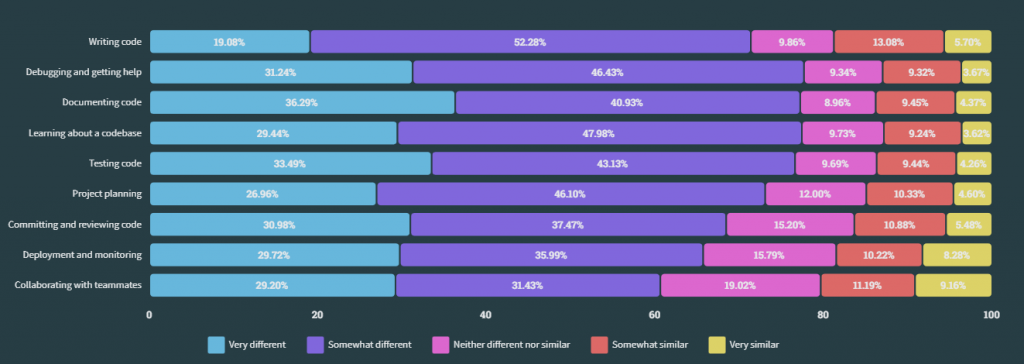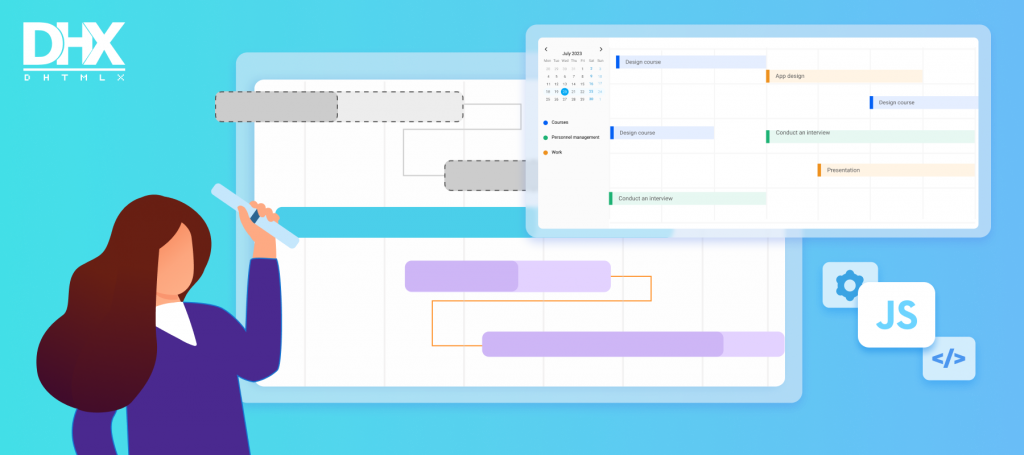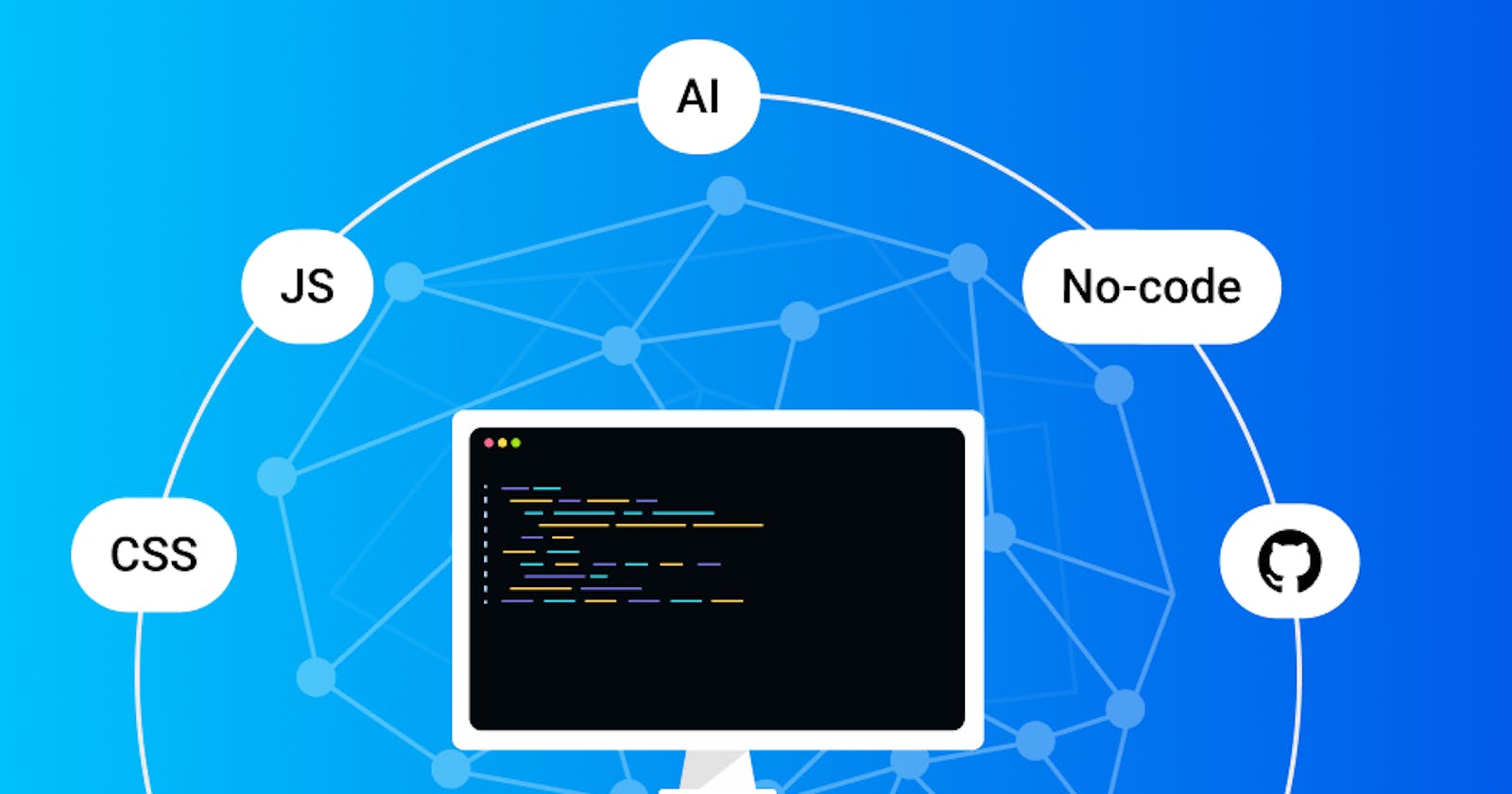Top Technology, Web Development, and JavaScript Trends to Follow in 2024
Table of contents
- AI Becomes Mainstream in Global Industry
- JavaScript and Its Prospects for Next Year
- CSS is Moving in the Right Direction
- GitHub’s Insights into the State of Open Source
- Rise of Low-/No-Code App Development
- Businesses Will Continue Spending More on PM Software
- Startups May Hope for a Better Share in 2024
- DHTMLX Continues Updating Product Portfolio and Launches Discount Program for Startups
The recent years have been very challenging for many industries, including IT. But despite all the odds, the worldwide programming population continues growing along with software spending, and many interesting trends take shape in the industry each year. Being in some way a part of this process on the web landscape, the DHTMLX team keeps an eye on major changes in web development, especially in JavaScript, and tries to predict what to expect in the future.
This year passes under the sign of AI technologies, and we certainly discuss their impact on the programming world. We’ll highlight the state of things in JavaScript, CSS and other relevant questions. For instance, we’ll discuss what’s going on in open source, the increased adoption of no-/low-code app-building approaches, the latest developments in project management software, and how things unfold for startups. We’ll also share with you the brightest DHTMLX moments in 2023 and our goals for 2024.
AI Becomes Mainstream in Global Industry
Today, many technologically advanced industries are already actively leveraging artificial intelligence (AI), and this trend will only grow. In essence, AI enables digital computers to perform tasks in a human-like manner. Traditional AI uses predetermined algorithms and rules to execute certain tasks and produce expected results. This form of AI has been known to the general public for years thanks to such tools as voice assistants like Siri and Alexa or chess programs.
The recent hype around AI mainly refers to another AI form called generative AI (GenAI), which is capable of providing new forms of creative content using learned patterns. The explosive popularity of GenAI is particularly noticeable in the IT industry, where the appearance of ChatGPT has become a sensation. It is hard to find a person in the IT world who knows nothing about GenAI and ChatGPT in particular.
The latest annual McKinsey Global Survey on the current state of AI confirms the tremendous growth of GenAI tools. Although these tools have been around not so long, the survey says that experimenting with the GenAI tools is already a common practice across industries.

Source: McKinsey Global Survey
The most commonly reported usage scenarios of GenAI tools are in marketing and sales, product and service development, and service operations. Survey respondents expect that GenAI will have a positive impact on the competitive capabilities of their companies in the coming years.
The survey also shows that many companies haven’t taken any measures yet to handle potential risks associated with GenAI tools. It is said that only 21% of respondents reporting AI adoption say their organizations have established policies related to using AI in their work.

Source: McKinsey Global Survey
Organizations continue to see returns in the business areas in which they are using AI and plan to increase investment in the years ahead.

Source: McKinsey Global Survey
Summing up, it is hard to argue that AI technologies have tremendous potential to become more helpful for various industries in 2024, but at the same time, insufficient attention to the associated risks may backfire.
Now it is time to delve into the programming world and see how AI technologies take root there.
JavaScript and Its Prospects for Next Year
Many online platforms regularly conduct research and compile curious rankings on the popularity of programming languages and other related topics. Such rankings are based on different criteria and methodologies, therefore you should not be surprised not to find JavaScript on top of each list.
If you look at the latest answers to this question from Statista, GitHub, and Stack Overflow, you will see a familiar picture of JavaScript being put in the first place.

Source: Developer Survey 2023
At the same time, some other known platforms (such as TIOBE, IEEE Spectrum, and PYPL) give the popularity crown to Python, but JavaScript remains among the leaders in these rankings as well.

Source: IEEE Spectrum
It is also necessary to note that TypeScript has been consistently growing in usage over the last few years. And it has become quite common for developers to migrate from JavaScript to TypeScript. But in general, we can say that JavaScript is still quite popular among web developers, and it is very unlikely to be replaced by any other language anytime soon.
One of the key secrets of JavaScript’s popularity is its vast ecosystem with numerous frameworks and other web technologies that simplify and speed up the development process. What are the latest tendencies here? To answer this question, we will use the results of the 2023 Developer Survey from Stack Overflow.
Professional developers who participated in this survey predictably chose React and Node.js as the most popular web technologies. But when talking about the most admired web frameworks and technologies, the leader of the previous year in this nomination – Svelte – is overtaken by Phoenix. Written in Elixir, this web framework promises a combination of developer-friendly features and high-performance characteristics.

Source: Developer Survey 2023
This year, the survey also includes a new section devoted, as you may have guessed, to AI technologies. In this section, respondents shared their views on the current usage of AI tools in the development process and their expectations from AI for the next year.
For instance, interviewed developers actively used AI-powered search tools such as ChatGPT (83%), Bing AI (20%), WolframAlpha (13%), etc. over the past year. As for the development process itself, developers resorted to using GitHub Copilot (54%), Tabnine (12%), AWS CodeWhisperer (5%), and other AI developer tools. Such tools are used in the development workflow for writing code, debugging and getting help, documenting code, testing code, and more. People assume that AI tools will considerably affect the development workflow, and the table below provides interesting info in this regard:

Source: Developer Survey 2023
Participants of the 2023 Developer Survey are quite enthusiastic about AI tools, but there are also some legitimate concerns linked to the accuracy of these tools.
CSS is Moving in the Right Direction
The newest State of CSS 2023 survey is already publicly available, so we should not miss an opportunity to review the latest web trends in the area of style and design. The survey provides interesting insights about CSS features, frameworks, CSS-in-JS libraries, and more.

Source: State of CSS 2023
According to survey respondents, the most used CSS features in 2023 are CSS variables, gap property for flexbox, and CSS filter effects. CSS nesting has gained the highest awareness during the last twelve months compared to other features, and it may also grow in usage soon as well.
When we take a look at the survey section dedicated to CSS frameworks, we see a familiar picture: Tailwind CSS chasing Bootstrap in awareness and usage criteria. But it is also interesting to point out the high “Interest” and “Retention” rankings of little-known Open Props and UnoCSS. Generally, it seems that the usage of CSS frameworks is on the decline now, while new CSS features are trending upwards.

Source: State of CSS 2023
This survey also includes some other noteworthy findings related to the usage of CSS. For instance, the list of top requested features named by the participants includes animation of an element’s dimension to auto, masonry layout, and support for SVG syntax in CSS code. When writing CSS code, developers also complain about various pain points found in browser compatibility, form elements styling, architecture, and maintenance issues. But at the same time, the majority of survey respondents are happy with the current state of CSS.
Surprisingly, this survey does not touch the topic of AI in CSS. However, it does not mean that AI cannot be helpful in CSS. For instance, AI algorithms can be applied for automated style generation, performance optimization, predictive design, and dynamic modification of the layout and color scheme.
So let us wait and see if AI will occupy a more important position in CSS in 2024.
GitHub’s Insights into the State of Open Source
Now, we turn to the new edition of the Octoverse report from GitHub to learn the latest developments in the field of open-source. This report includes plenty of impressive statistics and facts indicating the growth of the most popular open-source platform.
At the start of 2023, GitHub reached an astonishing mark of 100 million developer accounts, and now this number increased by 26%. One more significant achievement of this year is 420 million projects registered on GitHub, where 98 million of them were launched in 2023. This year, the number of first-time contributors (those who joined the platform in 2023) to open-source projects reached the highest numbers than ever before. Interestingly, public activity on GitHub accounts only for 20%, meaning that 80% of collaboration on GitHub happens in private projects.

Source: Octoverse 2023
AI technologies played a significant role in the increased developers’ activity on GitHub. This year, many developers used GitHub for experimenting and collaborating on generative AI, leading to a growing number of AI-powered open-source and public projects. According to the report, 65,000 generative AI projects were started in 2023, indicating a 248% year-over-year increase.

Source: Octoverse 2023
GitHub seems like an ideal place for sharpening AI skills and setting the stage for the widespread adoption of AI technologies.
And lastly, we would like to note that JavaScript remains the most popular programming language for open-source projects.
Rise of Low-/No-Code App Development
Following digital transformation trends, many organizations invest in the development of business apps to improve their efficiency in internal processes, services, and customer interactions. However, the problem is that the demand for such solutions is higher than the capacity of IT teams to deliver them. According to IDC, approximately 750 million apps will be required between 2023 and 2025, and finding qualified developers and technical specialists for this work is not an easy task.
That is where low-code and no-code development approaches come into play. These are promising alternatives to standard coding for building modern apps with less time and effort. Based on the principles of automatic code generation and visual programming, these approaches involve intuitive graphical tools and embedded functionalities, which require minimum coding (low code) or no programming knowledge at all (no code).
There are many low-code (OutSystems, Appian, Mendix) and no-code (Bubble, Adalo, Webflow) platforms that provide a spectrum of features for building applications, from simple prototypes to complex enterprise solutions. According to Gartner, the no-code and low-code platform market has grown from $8 billion in 2022 to $10 billion in 2023 and will reach $12.3 billion in 2024.

Source: Gartner
Using such platforms offers a range of benefits, and the main of them are:
Faster development
Cost efficiency
Short learning curve
Ease of use
Increased automation
Flexibility and customization
Lower maintenance burden
It is interesting to note that low-code and no-code technologies can make it easy to get started with AI. There are no-code/low-code AI tools aimed at building apps that leverage machine learning in innovative ways. As an example of such a tool, we can name Notion Data Service, which comes with an AI-powered assistant used for solving such tasks as configuring models, creating reports, and managing data.
Taking into account the increased demand for innovative app development, it is highly likely that low-code and no-code technologies will flourish in 2024.
Businesses Will Continue Spending More on PM Software
In today’s complicated business environment, project managers and other representatives of executive staff in companies should be aware of the latest project management trends.
Project management software tools continue to be vital for effective work in many industries and organizations. For instance, 70% of participants in one of Capterra’s surveys say that they rely on project management tools. Moreover, Capterra’s 2023 Successful Change Management Survey reveals that 58% of respondents consider better software tools as a way to improve their effectiveness in project management.
In 2023, many businesses spent a lot of money on project management tools despite recession warnings, and it seems like the same will happen in 2024. Most of the participants in Capterra’s 2024 Tech Trends survey said that their organizations plan to spend more on software the following year. As providers of JavaScript components for building project management apps, we admit that many businesses eagerly invest in developing custom software solutions to cater to their requirements.

Project management is a complex process that requires modern software tools, therefore no wonder that AI technologies are already put to use in project work. According to the Project Management Institute (PMI), the role of AI in project management will only continue to grow.

AI-powered PM software addresses some tricky aspects of project management, such as task automation, predictive analysis, scheduling optimization, risk management, resource allocation, and more. It helps project management to make informed decisions and improve project results. Here are the main reasons and benefits of investing in AI within project management found by the Capterra team in one of the recent surveys:

It is said in the report that 93% of AI early adopters have experienced a positive return on investment in the last 12 months. Companies plan to increase investment in AI for their project management function by nearly a third (32%), on average, by 2024, compared to their current investment.
But despite the great excitement revolving around AI technologies, there may be potential difficulties in adopting AI in project management:

That makes it even more interesting to see how the story about AI in project management will unfold in 2024.
Startups May Hope for a Better Share in 2024
Many startup businesses probably want to forget 2023 as a bad dream. This year, young businesses have been dealing with numerous unfavorable circumstances, such as a decline in startup funding, higher competition on deals, and a tough climate for negotiations. As a rule, any economic and political downturns are often followed by recoveries. According to the TechCrunch platform, startups have three main reasons to expect positive changes in 2024:
Growth rebound in the software market
Improved venture investing
Revival of the IPO market
These prerequisites for a brighter next year have much to do with high hopes for AI technologies. Generative AI became a source for big VC deals between tech giants and startups, promising continued startup outcomes during a tech recession. According to PitchBook, generative AI startups received a total of $23.2 billion as of October 15, 2023 – already a 250.2% increase over 2022’s total.

In the face of rough economic times, startups may also consider other financing options such as government-sponsored funding, accelerator programs, and mergers and acquisitions (M&A) deals. When talking specifically about web development that is closer to our field of expertise, startups can participate in various discount programs organized by popular software vendors.
All in all, no one can guarantee that things will come back to normal for startups in 2024, but, as mentioned above, there are reasons for optimism on this matter.
DHTMLX Continues Updating Product Portfolio and Launches Discount Program for Startups

The DHTMLX team has been closely monitoring all twists and turns in the rapidly changing landscapes of web development and JavaScript. Being up to date with the latest trends helps us to respond to the needs of existing and potential customers.
For instance, the current unstable political and economic situation in the world certainly makes investors very cautious about financing any web project. It can be a serious problem for startups, where lack or shortage of investments often turn out to be an insurmountable obstacle. This year, we’ve launched a special DHTMLX discount program to assist startup businesses deliberating over the usage of our products in their apps.

This initiative allows startups to purchase top DHTMLX JavaScript UI components (Gantt, Scheduler, Suite) with 70% discounts and benefit from them at the early stages of their web or cloud-based projects. In addition to a huge discount, this program provides personalized technical support and a large base of support materials.
In light of the consistently high demand for project management tools, we updated most of our JavaScript components for project management during the year. The most notable are major updates of our Gantt component with significant API improvements and Event Calendar enriched with top features for managing appointments.
Moreover, we published numerous tutorials on our blog and video guides on our YouTube channel to help web developers make the most of the DHTMLX tools in their project management apps.
We should also mention four updates, including the major one, of our JavaScript UI widgets library. These releases offer some general improvements such as customizable built-in themes and full compliance with web accessibility guidelines. Moreover, there are plenty of new features for top Suite widgets such as Grid, TreeGrid, Form, Charts, etc.
This year, our development team expanded the list of DHTMLX integrations with popular frameworks and other web technologies and you’ll see more of them in 2024.
Next year, we are also determined to continue our work on delivering the most demanded features for our JavaScript UI component libraries and contribute to their competitive power in the rapidly changing web development world.
